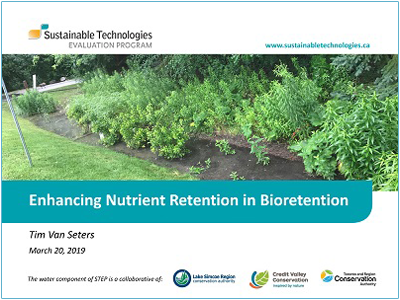TRACK 1
Enhancing Nutrient Retention in Vegetated Low Impact Development Practices: Insights from Field Monitoring Studies
ABSTRACT
Bioretention and other vegetated low impact development (LID) practices with underdrains have been shown to act as a source of phosphorus and other nutrients.
These nutrient sources include the filter media, which contains organic enriched soils to support plant growth, and seasonal leaf fall from plants inside or surrounding the practice.
To help mitigate nutrient release from vegetated LIDs, filter media specifications often suggest limits on soil-available phosphorus; in some cases reactive media are also added to enhance nutrient retention within or below the media layer.
This presentation provides an overview of nutrient loading into and out of several bioretention facilities in the GTA, and presents results from a two-year field study comparing the nutrient and water quality performance of three configurations of bioretention draining runoff from the same parking lot:
- One with a high-sand, low-phosphorus filter media mix
- One with a proprietary-engineered reactive media mixed into the conventional filter media
- One with a layer of iron-rich red sand below the filter media.
The presentation will also cover key factors influencing nutrient performance of reactive media.
Learning Objectives
1. What is the typical profile of nutrients in runoff from paved and vegetated surfaces?
2. How much variability can be expected in the nutrient performance of bioretention practices?
3. What can be done to mitigate phosphorus release from vegetated low impact development practices, and how well do these perform relative to one another?
ABOUT THE PRESENTER

Tim Van Seters
Tim Van Seters manages the Sustainable Technologies Evaluation Program (STEP) at Toronto and Region Conservation Authority (TRCA). He has more than 17 years of experience designing and implementing stormwater technology monitoring studies and developing best practice guidance on the implementation, operation and monitoring of such practices.
Throughout his career, Tim has provided advice on the design and construction of stormwater facilities and published scientific reports and journal articles on hydrology and low impact development stormwater management.
Tim holds a Master’s degree specializing in water resource science from the University of Waterloo and a Bachelor of Science degree from the University of Toronto.

